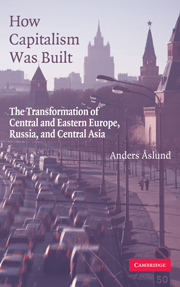Book contents
- Frontmatter
- Contents
- List of Tables and Figures
- List of Abbreviations
- Acknowledgments
- Introduction: A World Transformed
- 1 Communism and Its Demise
- 2 Shock Therapy versus Gradualism
- 3 Output: Slump and Recovery
- 4 Liberalization: The Creation of a Market Economy
- 5 From Hyperinflation to Financial Stability
- 6 Privatization: The Establishment of Private Property Rights
- 7 An Inefficient Social System
- 8 Democracy versus Authoritarianism
- 9 From Crime toward Law
- 10 The Role of Oligarchs
- 11 The Impact of the Outside World
- Conclusions: A World Transformed
- Bibliography
- Index
Conclusions: A World Transformed
Published online by Cambridge University Press: 05 September 2012
- Frontmatter
- Contents
- List of Tables and Figures
- List of Abbreviations
- Acknowledgments
- Introduction: A World Transformed
- 1 Communism and Its Demise
- 2 Shock Therapy versus Gradualism
- 3 Output: Slump and Recovery
- 4 Liberalization: The Creation of a Market Economy
- 5 From Hyperinflation to Financial Stability
- 6 Privatization: The Establishment of Private Property Rights
- 7 An Inefficient Social System
- 8 Democracy versus Authoritarianism
- 9 From Crime toward Law
- 10 The Role of Oligarchs
- 11 The Impact of the Outside World
- Conclusions: A World Transformed
- Bibliography
- Index
Summary
The changes that have taken place in East-Central Europe and the former Soviet Union are nothing but extraordinary. At the same time, it is striking how uneven progress has been. Some countries appear to have done it all, but others have barely taken the first steps. Market economic reforms have been highly successful, whereas democratization has been only partially auspicious, and the introduction of the rule of law even less so.
To assess how far the region has proceeded, these countries are first summarized as five models. Next, major developments in the region are recapitulated, and finally, I try to suggest why certain policies succeeded in certain countries and not in others.
Five Models
The outcomes of the postcommunist transformation have been remarkably different. Today these 21 countries that were once so similar have become rather diverse. Eighteen have become market economies, but three (Belarus, Turkmenistan, and Uzbekistan) have not (see Table C.1). The same eighteen countries have privatized more than half of their economies, but the other three have not. East-Central Europe has become fully democratic, whereas the CIS reformers are at best partially democratic but mostly mildly authoritarian. The nonreformers are all tyrannies. Corruption and the weakness of the rule of law are worrisome, and the situation is worse where less other reforms have occurred. Inflation has been brought under control throughout the region in, or close to, single digits.
- Type
- Chapter
- Information
- How Capitalism Was BuiltThe Transformation of Central and Eastern Europe, Russia, and Central Asia, pp. 305 - 314Publisher: Cambridge University PressPrint publication year: 2007



